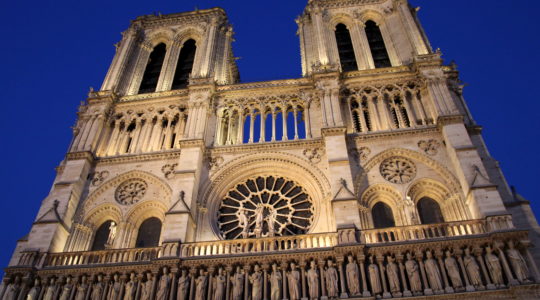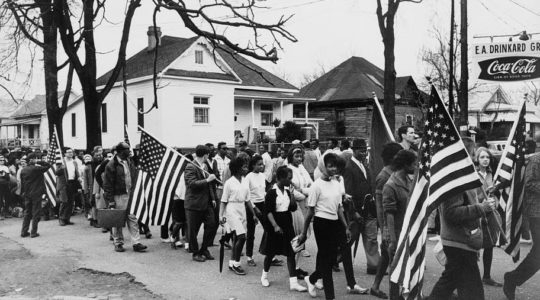For 47 years, Eve Blum didn’t know her father’s fate.
“I was blind and deaf to it,”says the soft-spoken Blum, 70. “It was in my mind, but in the back. It was asleep. My father had been deported — that was the only sentence, but it had no meaning.”
Her suppression abruptly ended in 1993, when a Holocaust historian revealed the unique story of Convoy 73, and found Blum’s father on a list of deportees.
Of the 79 deportations sent from the Paris suburb of Drancy between March 1942 and August 1944, Convoy 73 was the only one that didn’t terminate at a Polish or German concentration camp.
For reasons still unknown, it brought 878 French Jewish men to Kaunas, Lithuania and Tallinn, Estonia.
Only 23 of the men survived the war.
The discovery of Convoy 73 inspired Blum to make up for lost time. In 1995 she helped launch the Association of Friends and Family of Deportees of Convoy 73, and is about to complete her fourth book honoring the victims.
This week, Blum and 23 other members of the association visited the Baltics to unveil a gravestone on two sites where their brothers, fathers and grandfathers were brutally murdered in 1943 by the Nazis and their local collaborators — the Ninth Fort in Kaunas and Patarei Prison in Tallinn.
More than 100 people, including many elderly Lithuanians who survived the Ninth Fort, attended the moving ceremony in Kaunas, formerly known to many Jews by its Yiddish name, Kovno.
It was the fourth Baltic trip sponsored by the association, but the first for a handful of members.
“The first time it was terrible. It was very hard, very moving. The second time a bit less moving, but still difficult, and today too,” says Blum, who survived the Holocaust by hiding in the French countryside with a non-Jewish family. “This is the cemetery of our fathers. We like to go and to think about our fathers and brothers.”
Monique Hecker of Paris, whose father died in Kaunas, said, “I came here to finish this mourning that started 10 years ago.”
Until the groundbreaking discovery by historian Serge Klarsfeld, most families believed their loved ones were murdered in Auschwitz.
The association dates to May 15, 1993 — the 50th anniversary of the convoy — when nine separate classified advertisements appeared in the French newspaper Le Monde. Relatives of deportees placed the notices, searching for survivors or descendants who might have information.
Today the association boasts about 300 members representing 262 deportees. It has located relatives of the deportees in France, Britain, Belgium, Australia, Greece, the United States and Israel.
Blum says many families were annihilated, but insists other descendants simply don’t know about their link to the convoy.
In 1999, Blum, a retired secretary, wrote the association’s first book, “We Are 900 Frenchmen.” It features 48 biographies of victims.
In 2000, she published two subsequent volumes with 116 profiles submitted by relatives. A fourth book with 50 more contributions will be printed in October.
So far Blum has published more than 1,100 pages of memories.
The phrase “We Are 900 Frenchman” was carved into the wall of a cell in the Ninth Fort in Kaunas, and still can be seen today, along with various other markings in French.
Most members of the association are unsure if their relatives died in Kaunas or Tallinn, but on Tuesday the mystery ended for one member who found his father’s name engraved on the wall of the Ninth Fort.
The association was assisted by Alex Faitelson, a Lithuanian Jew who led a famous escape from the Ninth Fort in 1944. Though he fled six months before the Frenchmen arrived, Faitelson recently volunteered to help the association by tapping the Lithuanian archives and, in turn, providing the association with a list of deportees’ names.
Faitelson, who now lives in Israel, returned to Lithuania this week to meet the association members for the first time.
The association gathers annually on May 15 at the site of the deportation in Drancy. Relatives recite Kaddish, light candles and plan upcoming trips and projects.
The association is entirely self-supported financially. This year’s trip, along with the massive gravestone, was funded entirely by members.
More than 75,000 French Jews were deported from Darcy between 1942 and 1944. All but four of the deportations of these Jews went to Auschwitz. The other three arrived in Maidenek, Sobibor and Buchenwald.
Many questions about Convoy 73 still linger. No one knows, for example, why it ended up in the Baltics.
Some believe the Germans simply made a mistake, while others say the Nazis — under pressure as the Russian armies moved west, and with Auschwitz overcrowded — could count on the Lithuanians to murder the Jews quickly.
Blum says the all-male group was selected to work for the Todt Organization, which built roads and bridges across Eastern Europe.
Ten wagons carrying some 600 Jews terminated in Kaunas, while five wagons with roughly 300 Jews went on to Tallinn, most likely because the Ninth Fort was overcrowded. None of the deportees knew where he was headed.
Some men died during the three-day journey, in which 60 males were crammed into each train wagon without food or drink.
Two men survived in Kaunas, but both died in the 1970s before sharing details of the ordeal.
Two of the 21 survivors from Tallinn are still alive. One is 93, and made the trip to the memorial in 1995. The other refuses to talk about his Holocaust memories.
This week’s visit was the fourth for Hecker, 77, the only association member who knew her father’s destiny all along.
Hecker last saw her father Albert in southern France at 10:15 a.m. on May 15, 1943. They planned to meet at 1:30 p.m. at a train station.
From there, they hoped to escape over the Pyrenees Mountains to Spain and, eventually, to Africa.
Hecker’s father was arrested before he could meet his family. With little choice, mother and daughter fled, and survived.
In 1946, Monique placed a notice in a French newspaper. A man promptly phoned her and said, “Your father was sent to Kaunas.”
“My father engraved his name on the wall” in Drancy, Hecker said. “And some men of that convoy engraved their names in Kaunas. At that time we were very conscious of the fact that the Germans wanted to eradicate the Jews and eradicate any trace of them having ever existed. So when one writes his name it means, ‘I was there. We were here.’ “
“There is a trace,” she said. “And we are tracing them now.”
For more information, contact the association at http://www.convoi73.org.
JTA has documented Jewish history in real-time for over a century. Keep our journalism strong by joining us in supporting independent, award-winning reporting.
The Archive of the Jewish Telegraphic Agency includes articles published from 1923 to 2008. Archive stories reflect the journalistic standards and practices of the time they were published.



